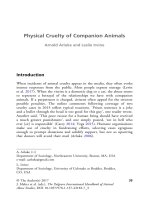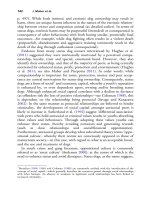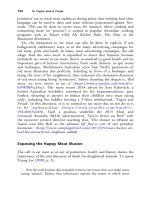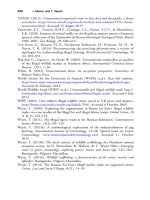The palgrave international handbook of a 259
Bạn đang xem bản rút gọn của tài liệu. Xem và tải ngay bản đầy đủ của tài liệu tại đây (26.01 KB, 1 trang )
Animal Abuse Resulting from Wildlife Habitat Destruction
255
found to be contaminated by GM corn, despite the fact that in 1998 Mexico
declared a moratorium on transgenic corn crops in order to preserve the
extraordinary biodiversity of the plant. Meanwhile, in Paraguay, where (as of
2007) no law authorised the cultivation of GMOs: ‘From 1996 to 2006,
surfaces devoted to soybean cultivation went from less than 2.5 million acres
to 5 million acres, an increase of 10 % a year’ (Robin 2010, p. 275). To avoid
losing markets and by ensuring proper labelling of crops for markets such as
the European Union, the Paraguayan government ended up simply legalising
the illegal crops. Much the same thing happened in Brazil and Poland
(Engdahl 2007), and for much the same reasons (namely EU rules on
traceability and labelling of GM foods intended for human and animal
consumption) (Robin 2010).
The lucrative market for biofuels and GM crops has been linked to the
forced takeover of communal lands, using armed men and bulldozers, as well
as fraudulent claims of land title (see Robin 2010). Moreover, given that the
focus of the UN mechanism for Reducing Emissions from Deforestation and
Forest Degradation (REDD) is on minimising carbon emissions caused by
the destruction of living forest biomass, there will be greater pressures to
convert or modify other ecosystems, especially savannahs and wetlands, for
food or biofuel (Sutherland et al. 2009). In other words, forests are privileged
over other types of ecosystems, and the result could well be the loss of
biodiversity associated with destruction or conversion of these ‘less valued’
non-forested ecosystems. Again, compulsory take-over of biodiversity-rich
land of any type is not uncommon. Recent land grabs in Cambodia and Laos
by Vietnamese companies and the subsequent clear-felling of intact forests
for the purposes of rubber plantations involves corrupt decision-making
processes at elite levels and systematic contravention of existing environmental laws (Global Witness 2013).
The conversion of land for commercial purposes is entirely relevant to the
wellbeing and survival of nonhuman animals. For example, the native woodlands demolished for cash crops such as GM soybeans in Argentina have a
major impact on the habitats of animals such as pumas, jaguars, Andean cats
and tapirs, which cannot survive outside this particular ecosystem (Robin
2010, p. 271). Similar events are happening in places such as Indonesia,
where deforestation is putting pressure on the Sumatran tiger and the
orangutan (Boekhout van Solinge 2008b).
Simultaneously, GMO technologies are also being applied to animals,
including fish, with potentially dire consequences. To put this into context
it is useful to consider several other interrelated factors that are putting
pressures on animal species around the world. One of these is the relationship









